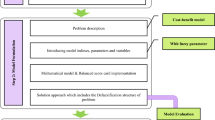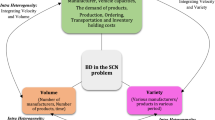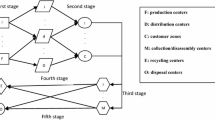Abstract
The issues of food safety and environmental protection are attracting more and more attention. Everyday, a large number of cold chain products are delivered from suppliers to customers. The cold chain products require refrigeration equipment in delivery and should be delivered to customers as soon as possible. Therefore, the challenge of reducing carbon emission and improving the customer satisfaction should be solved. This study presents the impact of carbon emission, customer satisfaction, construction cost, and operation cost on the location of cold chain logistics distribution center. A multi-objective location model for cold chain logistics distribution center considering carbon emission is established. The carbon emission equivalent cost model considers the dynamic carbon emission during transportation and the static carbon emission of the distribution center. The penalty cost under the time window is introduced into the penalty cost model of customer satisfaction, which represents a multi-objective mixed-integer linear programming problem. A non-dominated sorting genetic algorithm II (NSGA-II) is used to design the program through double-layer composite coding. NSGA-II uses a fast non-dominated sorting approach to reduce the computational complexity of non-dominated sorting. This algorithm uses the elitist control strategy, which does not need to share parameters and is more efficient in the multi-objective optimization process. The numerical results show that the proposed algorithm can generate appropriate Pareto solutions for all objectives.



Similar content being viewed by others
References
Agustina D, Lee CKM, Piplani RMG (2014) Vehicle scheduling and routing at a cross docking center for food supply chains. Int J Prod Econ 152:29–41
Anser MK (2019) Impact of energy consumption and human activities on carbon emissions in Pakistan: application of STIRPAT model. Environ Sci Pollut Res 26:13453–13463
Bao CL, Zhang SB (2018) Route optimization of cold chain logistics in joint distribution with consideration of carbon emission. Indust Eng Manag 23:95–107
Bilir C, Ekici SO, Ulengin F (2017) An integrated multi-objective supply chain network and competitive facility location model. Comput Ind Eng 108:136–148
Burek J, Nutter DW (2019) A life cycle assessment-based multi-objective optimization of the purchased, solar, and wind energy for the grocery, perishables, and general merchandise multi-facility distribution center network. Appl Energy 235:1427–1446
Cui ZF (2019) Review and prospect of China's cold chain logistics in 2018. China's logistics and procurement.4,12-13
Dan Z, Yu SC, Zhen L, Wang W (2016) Multi-period distribution center location and scale decision in supply chain network. Comput Ind Eng 101:216–226
Guerriero F, Surace R, Loscri V (2014) A multi-objective approach for unmanned aerial vehicle routing problem with soft time-windows constraints. Appl Math 38:839–852
Guo JM, Liu C (2018) Time-dependent vehicle routing of free pickup and delivery service in flight ticket sales companies based on carbon emissions. J Adv Transp 23:1–14
He Y, Wang X, Lin Y (2017) Sustainable decision making for joint distribution center location choice. Transp Res Part D: Transp Environ 55:202–216
Hsiao YH, Chen MC, Chin CL (2017) Distribution planning for perishable foods in cold chains with quality concerns: formulation and solution procedure Trends in Food. For Sci Technol 61:80–93
Hsu HW (2019) A Compromise Programming Model for Perishable Food Logistics under Environmental Sustainability and Customer Satisfaction.2019 IEEE International Conference on industrial engineering and application. Macao China.12.15.
Karami F, Vancroonenburg W, Van den Berghe GA (2020) Periodic optimization approach to dynamic pickup and delivery problems with time windows. J Sched
Kaur H, Singh SP (2017) Modeling low carbon procurement and logistics in supply chain: A key towards sustainable production. Sustain Product Consumpt 11:5–17
Ma ZJ, Wu Y, Dai Y (2017) A combined order selection and time-dependent vehicle routing problem with time widows for perishable product delivery. Comput Ind Eng 114:101–114
Mariano EB, Gobbo JAA, Camioto FC (2017) CO2 emissions and logistics performance: a composite index proposal. J Clean Prod 163:166–178
Musavi MM, Ali BA (2017) A multi-objective sustainable hub location-scheduling problem for perishable food supply chain. Comput Ind Eng 113:766–778
Musolino G, Rindone C, Polimeni A, Vitetta A (2019) Planning urban distribution center location with variable restocking demand scenarios: general methodology and testing in a medium-size town. Transp Policy 80:157–166
Naderipour M, Alinaghian M (2016) Measurement, evaluation and minimization of CO2, NOx, and CO emissions in the open time dependent vehicle routing problem. Measurement. 90:443–452
Nasri M, Metrane A, Hafidi I, Jamali A (2020) A robust approach for solving a vehicle routing problem with time windows with uncertain service and travel times. Int J Ind Eng Comput 11:1–16
Qin GY, Tao FM, Li LX (2019) A vehicle routing optimization problem for cold chain logistics considering customer satisfaction and carbon emissions. Int J Environ Res Public Health 16:576
Ruiz-Meza J, Montes I, Perez A (2020) VRP model with time window, multiproduct and multidepot. J Appl Sci Eng 23:239–247
Schneider M (2016) The vehicle-routing problem with time windows and driver-specific times. Eur J Oper Res 250:101–119
Shen L, Tao FM, Wang SY (2018) Multi-depot open vehicle routing problem with time windows based on carbon trading. Int J Environ Res Public Health 15:225–237
Spliet R, Dabia S, Van Woensel T (2018) The time window assignment vehicle routing problem with time-dependent travel times. Transp Sci 52:261–276
Wang J, Li H (2019) The mystery of local fiscal expenditure and carbon emission growth in China. Environ Sci Pollut Res 26:12335–12345
Wu L, Hifi M (2020) Discrete scenario-based optimization for the robust vehicle routing problem: the case of time windows under delay uncertainty. Comput Ind Eng 145:612–623
Zanoni S, Zavanella L (2012) Chilled or frozen? Decision strategies for sustainable food supply chains. Int J Prod Econ 140:731–736
Zhang Y, Baldacci R, Sim M (2019) Routing optimization with time windows under uncertainty. Math Program 175:263–305
Zulvia FE, Kuo RJ, Nugroho DY (2020) A many-objective gradient evolution algorithm for solving a green vehicle routing problem with time windows and time dependency for perishable products. J Clean Prod 242:66–78
Availability of data and materials
Not applicable.
Funding
This research was funded by the Shan Dong Natural Science Foundation, grant number ZR2020MG017.
Author information
Authors and Affiliations
Contributions
Xinguang Li: designed and performed the experiments, analyzed the data, and prepared the paper.
Kang Zhou: participated to collect the materials related to the experiment.
Corresponding author
Ethics declarations
Ethics approval and consent to participate
Not applicable.
Consent for publication
Not applicable.
Competing interests
The authors declare that they have no competing interests.
Additional information
Responsible Editor: Philippe Garrigues
Publisher’s note
Springer Nature remains neutral with regard to jurisdictional claims in published maps and institutional affiliations.
Rights and permissions
About this article
Cite this article
Li, X., Zhou, K. Multi-objective cold chain logistic distribution center location based on carbon emission. Environ Sci Pollut Res 28, 32396–32404 (2021). https://doi.org/10.1007/s11356-021-12992-w
Received:
Accepted:
Published:
Issue Date:
DOI: https://doi.org/10.1007/s11356-021-12992-w




